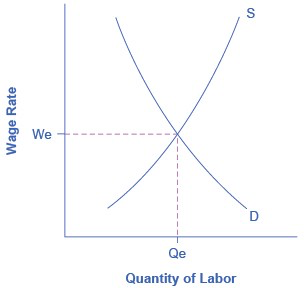Cyclical Unemployment - Explained
What is Cyclical Unemployment?
- Marketing, Advertising, Sales & PR
- Accounting, Taxation, and Reporting
- Professionalism & Career Development
-
Law, Transactions, & Risk Management
Government, Legal System, Administrative Law, & Constitutional Law Legal Disputes - Civil & Criminal Law Agency Law HR, Employment, Labor, & Discrimination Business Entities, Corporate Governance & Ownership Business Transactions, Antitrust, & Securities Law Real Estate, Personal, & Intellectual Property Commercial Law: Contract, Payments, Security Interests, & Bankruptcy Consumer Protection Insurance & Risk Management Immigration Law Environmental Protection Law Inheritance, Estates, and Trusts
- Business Management & Operations
- Economics, Finance, & Analytics
What is Cyclical Unemployment?
Let’s make the plausible assumption that in the short run, from a few months to a few years, the quantity of hours that the average person is willing to work for a given wage does not change much, so the labor supply curve does not shift much. In addition, make the standard ceteris paribus assumption that there is no substantial short-term change in the age structure of the labor force, institutions and laws affecting the labor market, or other possibly relevant factors.
One primary determinant of the demand for labor from firms is how they perceive the state of the macro economy. If firms believe that business is expanding, then at any given wage they will desire to hire a greater quantity of labor, and the labor demand curve shifts to the right. Conversely, if firms perceive that the economy is slowing down or entering a recession, then they will wish to hire a lower quantity of labor at any given wage, and the labor demand curve will shift to the left. Economists call the variation in unemployment that the economy causes moving from expansion to recession or from recession to expansion (i.e. the business cycle) cyclical unemployment.
From the standpoint of the supply-and-demand model of competitive and flexible labor markets, unemployment represents something of a puzzle. In a supply-and-demand model of a labor market, the labor market should move toward an equilibrium wage and quantity. At the equilibrium wage (We), the equilibrium quantity (Qe) of labor supplied by workers should be equal to the quantity of labor demanded by employers.

In a labor market with flexible wages, the equilibrium will occur at wage We and quantity Qe, where the number of people who want jobs (shown by S) equals the number of jobs available (shown by D).
One possibility for unemployment is that people who are unemployed are those who are not willing to work at the current equilibrium wage, say $10 an hour, but would be willing to work at a higher wage, like $20 per hour. The monthly Current Population Survey would count these people as unemployed, because they say they are ready and looking for work (at $20 per hour). However, from an economist’s perspective, these people are choosing to be unemployed.
Probably a few people are unemployed because of unrealistic expectations about wages, but they do not represent the majority of the unemployed. Instead, unemployed people often have friends or acquaintances of similar skill levels who are employed, and the unemployed would be willing to work at the jobs and wages similar to what those people are receiving. However, the employers of their friends and acquaintances do not seem to be hiring. In other words, these people are involuntarily unemployed. What causes involuntary unemployment?
Related Topics
- What is the US Labor Force?
- Out of the Labor Force
- Labor Force Participation Rate
- Establishment Payroll Survey
- Bureau of Labor Statistics
- Unemployment
- Underemployed
- Full Employment Equilibrium
- Okun's Law
- Issues with Measuring Unemployment
- Sticky Wage Theory (Economics)
- Implicit Contract Theory of Wages
- Efficient Wage Theory
- Adverse Selection of Wage Cuts Argument
- The Insider-Outsider Model
- Relative Wage Coordination Argument
- Natural Rate of Unemployment
- Frictional Unemployment
- Structural Unemployment
- Labor Productivity - Explained
- Okun's Law
- How does U.S. unemployment insurance work?
- National Average Wage Index
- Job Openings and Labor Turnover Survey
- Labor Surplus Area - Explained
- Lump of Labor Fallacy - Explained
- Bureau of Labor Statistics
- ADP National Employment Survey
- Labor Theory of Value - Explained
- Wage Elasticity of Labor Supply